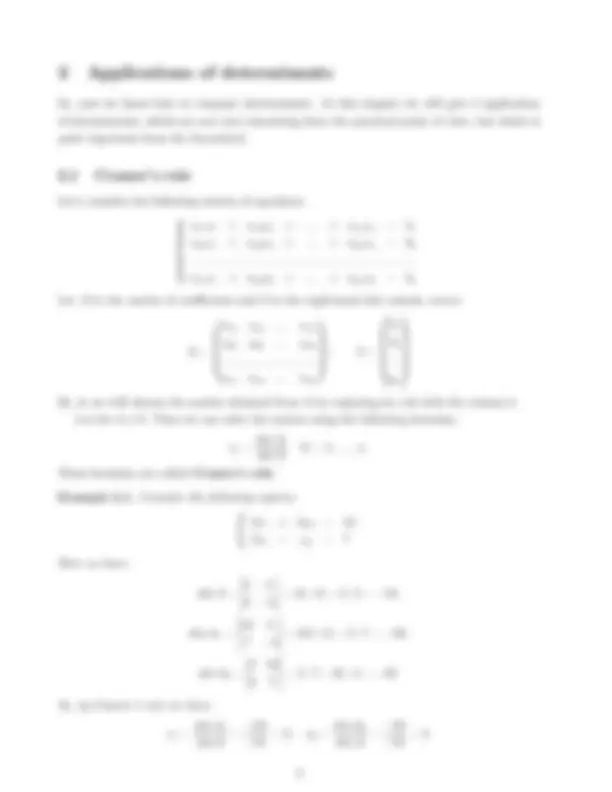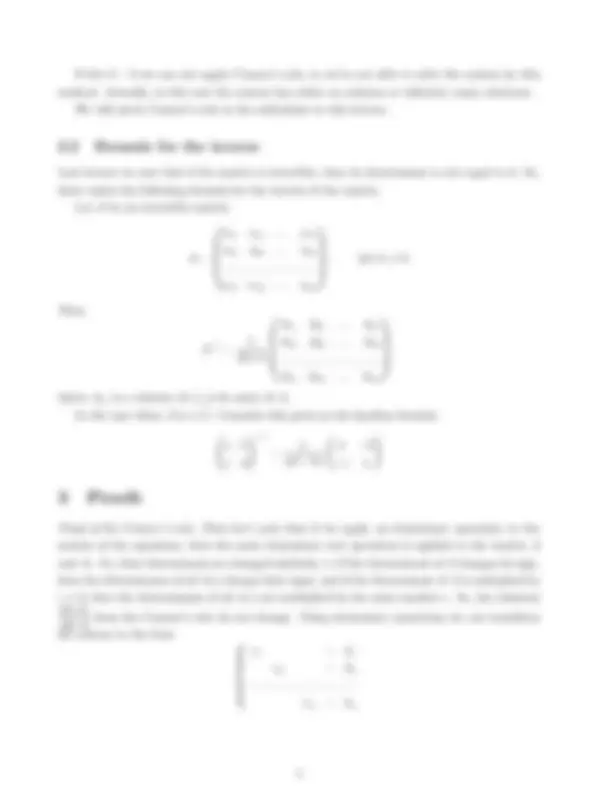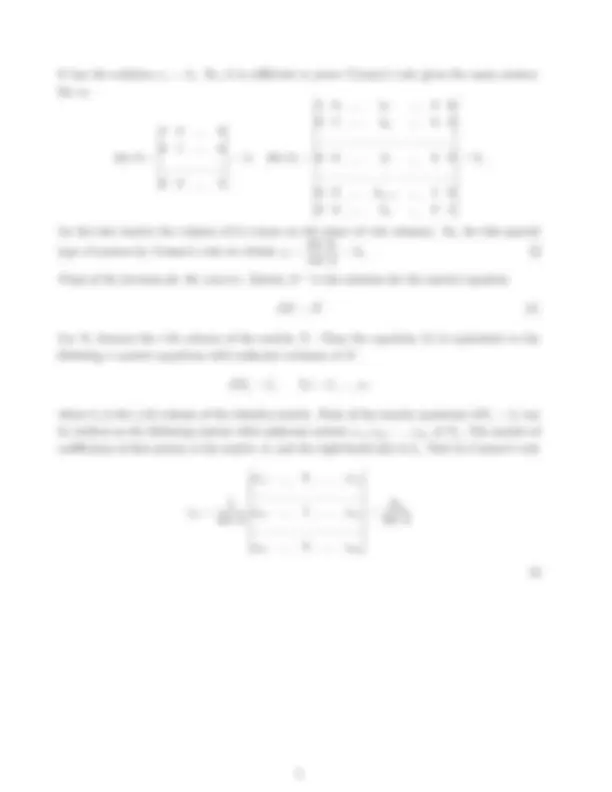





Study with the several resources on Docsity

Earn points by helping other students or get them with a premium plan


Prepare for your exams
Study with the several resources on Docsity

Earn points to download
Earn points by helping other students or get them with a premium plan
Community
Ask the community for help and clear up your study doubts
Discover the best universities in your country according to Docsity users
Free resources
Download our free guides on studying techniques, anxiety management strategies, and thesis advice from Docsity tutors
Row Column Expansion, Expansion, Determinant, Induction, Cramer's Rule, Inverse, Linear Algebra, Lecture Notes, Andrei Antonenko, Department of Applied Math and Statistics, Stony Brook University, New York, United States of America.
Typology: Study notes
1 / 5

This page cannot be seen from the preview
Don't miss anything!




This lecture we will give a nice example of application of a row expansion to computing the
determinant of a large matrices.
Let An be the matrix with n rows and n columns of the following form.
An =
So it is a matrix with 2’s on a diagonal and 1’s strictly above and below it. Our goal is to
compute the determinant of An as a function of n.
First we will use expansion by the first row. We will have:
det An =
= 2 det An− 1 −
For the last matrix we will use expansion by the first column. So, the initial determinant will
be equal to:
det An = 2 det An− 1 − 1 ·
This last matrix is a (n − 2) × (n − 2)-matrix of the same type, so we got the following equality:
det An = 2 det An− 1 − det An− 2.
Now let’s compute det A 1 and det A 2.
det A 1 =
∣ = 2; det A 2 =
Now by this formula we can compute larger determinants, e.g.:
det A 3 = 2 det A 2 − det A 1 = 2 · 3 − 2 = 4;
det A 4 = 2 det A 3 − det A 2 = 2 · 4 − 3 = 5;
det A 5 = 2 det A 4 − det A 3 = 2 · 5 − 4 = 6.
Looking at these determinant we’re able to guess the general formula:
det An = n + 1.
It is not proved yet, it is just our guess. But we can use mathematical induction to prove it:
Proof. Base of induction. For n = 1 det A 1 = 2 = 1 + 1 — formula is true. For n = 2
det A 2 = 3 = 2 + 1 — formula is true.
Step of induction. Let the formula be true for det Ak, i.e. det Ak = k + 1 and det Ak− 1 ,
i.e. det Ak− 1 = k. Now, by our recurrent relation:
det Ak+1 = 2 det Ak − det Ak− 1 = 2(k + 1) − k = k + 2 = (k + 1) + 1,
so, our guess is true in general.
In this example we just guessed the general formula, and it may be difficult to do it in
general, when it is more complicated. There is a whole theory how to solve recurrent relations
(which is not difficult, on the contrary, it is quite short and simple), but in this course we will
not cover it.
If det A = 0 we can not apply Cramer’s rule, so we’re not able to solve the system by this
method. Actually, in this case the system has either no solution or infinitely many solutions.
We will prove Cramer’s rule in the addendum to this lecture.
Last lecture we saw that if the matrix is invertible, then its determinant is not equal to 0. So,
there exists the following formula for the inverse of the matrix.
Let A be an invertible matrix:
a 11 a 12... a 1 n
a 21 a 22... a 2 n
an 1 an 2... ann
, det A 6 = 0.
Then
det A
A 11 A 21... An 1
A 12 A 22... An 2
A 1 n A 2 n... Ann
where Aij is a cofactor of (i, j)-th entry of A.
In the case when A is a 2 × 2-matrix this gives us the familiar formula
a b
c d
ad − bc
d −b
−c a
3 Proofs
Proof of the Cramer’s rule. First let’s note that if we apply an elementary operation to the
system of the equations, then the same elementary row operation is applied to the matrix A
and Ai. So, their determinant are changed similarly, i.e if the determinant of A changes its sign,
then the determinants of all Ai’s change their signs, and if the determinant of A is multiplied by
c 6 = 0, then the determinants of all Ai’s are multiplied by the same number c. So, the relations
det Ai
det A
from the Cramer’s rule do not change. Using elementary operations we can transform
the system to the form
x 1 = k 1
x 2 = k 2
xn = kn
It has the solution xi = ki. So, it is sufficient to prove Cramer’s rule gives the same answer.
For it:
det A =
= 1; det Ai =
1 0... k 1... 0 0
0 1... k 2... 0 0
0 0... ki... 0 0
0 0... kn− 1... 1 0
0 0... kn... 0 1
= ki
(in the last matrix the column of bi’s stays on the place of i-th column). So, for this special
type of system by Cramer’s rule we obtain xi =
det Ai
det A
= k 1.
Proof of the formula for the inverse. Matrix A
− 1 is the solution for the matrix equation
Let Xi denotes the i-th column of the matrix X. Then the equation (1) is equivalent to the
following n matrix equations with unknown columns of X:
AXj = Ij ∀j = 1,... , n,
where Ij is the j-th column of the identity matrix. Each of the matrix equations AXj = Ij can
be written as the following system with unknown entries x 1 j , x 2 j ,... , xnj of Xj. The matrix of
coefficients of this system is the matrix A, and the right-hand side is Ij. Now by Cramer’s rule
xij =
det A
a 11... 0... a 1 n
aj 1... 1... a 1 n
an 1... 0... ann
Aji
det A